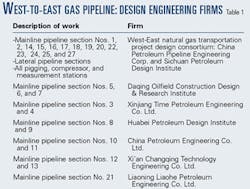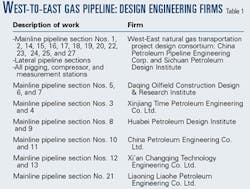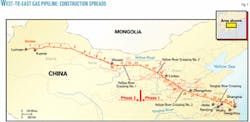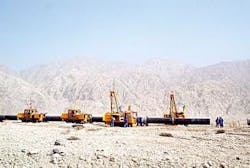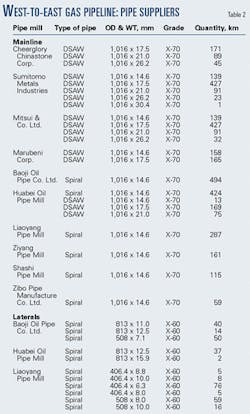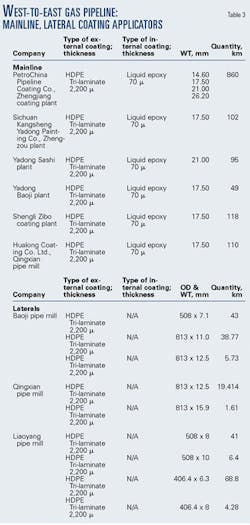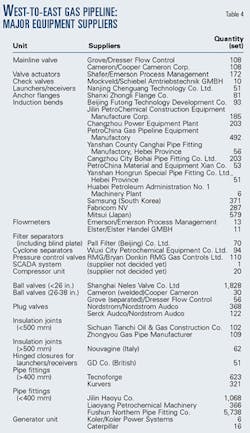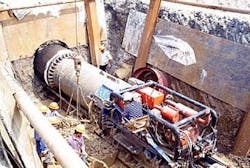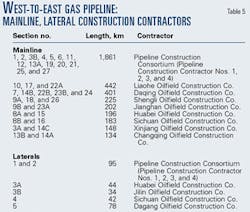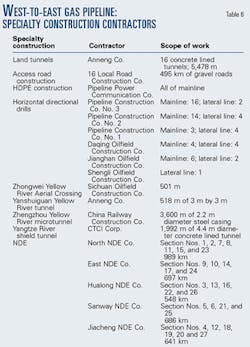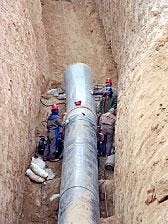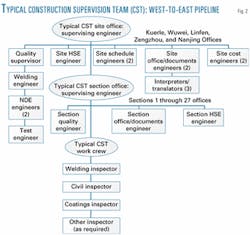Chinese gas pipeline design, contractors target full start-up for 2004
PetroChina Co. Ltd.'s West-to-East natural gas pipeline project has been under construction since October 2001 and is proceeding toward a 2004 completion of the approximate 3,800 km, 1,016-mm (40-in.) mainline.
This second article in a three-part series describes the project's design and specifications, significant material suppliers and contractors, and construction plan, schedule, and management.
Part 1 (Mar. 17, 2003, p. 68) provided an overview of the project, its rationale and status.
The concluding article, to follow in a few weeks, will describe some of the major obstacles faced by the project and how they are being overcome.
Project design
The size and schedule of the project have required that the pipeline design be performed by several pipeline design engineering firms in China, consisting of West-East Natural Gas Transportation Project Design Consortium, Daqing Oilfield Construction Design & Research Institute, Xinjiang Time Petroleum Engineering Co. Ltd., Huabei Petroleum Design Institute, China Petroleum Engineering Co. Ltd., Xi'an Changqing Technology Engineering Co. Ltd., and Liaoning Liaohe Petroleum Engineering Co., Ltd.. The design work has been divided among domestic design engineering firms as listed in Table 1; Fig. 1 shows the mainline section locations.
null
The mainline is designed for a 10 mPa maximum allowable operating pressure and ultimate transportation capacity of 34.3 million cu m/day (1.2 bcfd) of natural gas when the pipeline and the proposed compression are completed.
The project's 294 km of lateral pipelines are designed for a 6.2 mPa MAOP. Although the pipeline will initiate natural gas service near the end of 2003, its ultimate design capacity and all compression are not required until the downstream markets fully develop, around 2008.
Because the mainline pipeline will incrementally increase flow to markets until it reaches capacity in 2008, compressor units will be added to the pipeline system in stages. Current plans call for installation of four units in 2004, two in 2005, and four in 2006.
The pipeline will ultimately include ten mainline compressor stations consisting of two 25-Mw centrifugal compressor units. Six of the mainline compressor stations will be gas-turbine driven and four will be electric-motor driven.
At this time, bids for the mainline compressor units are being evaluated; no vendor has been selected.
The pipeline system includes 16 delivery metering stations. All of the pipeline delivery stations are in the eastern section of the mainline and include deliveries to power generation, industrial, and distribution customers. The project has adopted ultrasonic measurement for custody transfer of the gas.
Materials, suppliers
Tables 2-4 list the project's pipe, coating, and major equipment suppliers.
Table 2 shows that PetroChina, as owner, decided to use spirally welded line pipe in Class 1 and 2 locations and long-seamed line pipe in Class 3 and 4 locations on the mainline. All mainline pipe was manufactured with the double-submerged-arc weld process.
The line pipe was manufactured in average 13-m lengths. Because rail cars were unavailable and remote areas had such poor roads, line pipe could not be double jointed into 26-m lengths for transportation to the construction site.
Line pipe has been provided by both Chinese and foreign pipe mills in order to meet the project schedule. It should be noted that China put into commercial operation its first DSAW pipe mill in fall 2002 in Guangzhou.
The primary external pipe coating is a three-layer fusion-bonded epoxy (FBE) and polyethylene system, and the internal pipe coating is an epoxy-based paint. All pipe coating has been applied by Chinese pipe coaters as shown in Table 3.
To date, the West-to-East project has used 2,071 1,016-mm induction bends. These bends were manufactured from the project's line pipe for Class 1, 2, and 3 locations. A special order of 30.2 mm X-70 line pipe, however, was required for the induction bends in Class 4 locations. Also, induction bends have been provided by both Chinese and foreign suppliers in order to meet the schedule.
The other major equipment listed in Table 4 is being manufactured with deliveries that began last month and will continue through the year. Priorities have been placed on major equipment needed for completion and operation of the eastern section of the pipeline from Jingbian to Shanghai.
Construction plan, schedule
The project's construction plan was developed with targets to initiate operation of Phase 1 of the pipeline by yearend 2003 and Phase 2 of the pipeline by yearend 2004. This construction plan included separating the 3,800-km pipeline into 27 construction spreads and the lateral pipelines into 6 construction spreads (Fig. 1).
null
The mainline construction contractors are also responsible for all compressor, pigging, and meter stations in their construction spreads.
All construction on the project is being performed by domestic Chinese contractors. The only contractor not from mainland China is CTCI Corp., Taiwan, which is performing the tunneling work beneath the Yangtze River. Table 5 lists the mainline and lateral pipeline construction contractors employed by the West-to-East project and their scopes of work.
Table 6 lists the other domestic contractors performing specialty construction work on tunnels, access roads, horizontal directional drills, nondestructive examination (NDE), and high-density polyethylene (HDPE) fiberoptic conduits.
The mainline and lateral pipeline construction on Phase 1 is to be completed, including start-up and commissioning, by yearend 2003. The mainline is essentially mechanically complete at this time with hydrostatic testing and drying work being performed. Installation of the station facilities started in March and will complete by the end of September.
The mainline construction plan for Phase 2 was initiated with spread Nos. 3, 6, 7, 8, 9, 10, 11, and 12 starting in March. Spread Nos. 4, 5, and 13 will start in July with all scheduled for mechanical completion by yearend 2004 with hydrostatic testing and drying completed in 2004.
Installation of the initial compressor stations is to start in 2004-05 with completion of all stations in 2005-12. Additional compressor station installations will be scheduled as throughput in the pipeline increases with market demand.
Construction management
PetroChina designed a construction supervision model consisting of a foreign firm working in partnership with a Chinese construction supervision firm to supervise the pipeline's construction.
null
Universal Ensco Inc., Houston, has been working with Longway Construction Supervision Co., Langfang, Hubei Province, on the overall supervision of the project from a headquarters office in Beijing and project site offices in Kuerle, Linfen, Zhengzhou, Nanjing, Wuwei, and at the Yangtze River crossing (Fig. 1).
The management scheme is using foreign staff as department heads in the Beijing headquarters office for all project construction supervision disciplines including quality control; health, safety, and environment; document control; cost; and schedule. The domestic supervision company provides assistant department heads and staff.
At each project site office, the foreign company provides the chief supervising engineer and a quality and safety engineer, and the domestic company provides the assistant chief supervising engineer and all staff.
Section (or spread) offices are staffed fully by the domestic supervision company. Fig. 2 shows a typical project site office, section office, and work crew supervision organization.
Table 7 lists the Chinese domestic supervision companies utilized in construction supervision.
Numbering error
In "US midstream standing at yet another critical juncture" by Peter Fasullo (OGJ, Apr. 21, 2003, p. 56), the numbering of figures and tables was incorrect. The first reference to "Fig. 2" should have been to Table 1. Subsequent figure and table textual references should be as follows, in order of appearance: "Fig. 3" refers to Fig. 2; "Fig. 4" to Fig. 3; "Fig. 5" to Fig. 4; "Fig. 6" to Fig. 5; "Table 1" to Table 2; "Table 2" to Table 3; "Table 3" to Table 4; and "Fig. 7" to Fig. 6.
